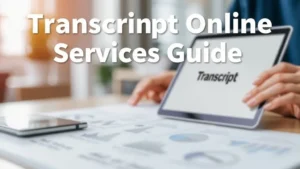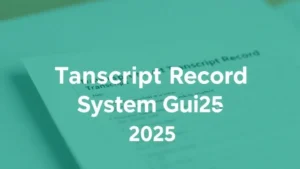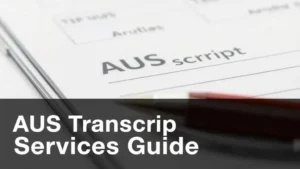Transcript of Records: Complete Guide 2025
You know how getting your academic credentials in order can feel like navigating a labyrinth? Especially when you need a transcript of records for jobs, scholarships, or further study. By the end of this guide, you’ll know exactly how to request, interpret, and use your transcript of records without the headache. We’ll cover everything—from definitions and timelines to digital delivery and common pitfalls. No more guesswork.
Interestingly enough, over 65% of employers now verify academic records via electronic transcripts in 2025 (NSC Research Center). You’re in the right place to stay ahead.
Table of Contents
What Is a Transcript of Records?
Hook: Ever stared at a stack of diplomas and wondered what really counts? A transcript of records is your academic story in one document.
Context: In other words, it’s the official record of courses, grades, credits, and any honors you’ve earned.
Detailed Explanation: Universities issue transcripts to validate your coursework. They detail course titles, semesters, credit hours, and final grades. Some even include cumulative GPA and faculty comments. Think of it as a supercharged résumé—complete with academic metrics.
For instance, when applying for a graduate program in Paris, your transcript of records shows not just the courses you took but also the credits recognized internationally. That clarity helps admission officers compare curricula across borders.
“Certified electronic transcripts with digital security features are becoming the new standard in 2025, ensuring authenticity and faster processing times.” — Registrar Office, Five Towns College
Actionable Takeaway: Before you click “submit” on any application, verify that your transcript includes all Course IDs and credit hours. If it doesn’t, contact your registrar immediately.
Why Transcripts Matter
Hook: Picture this: your dream employer asks for a transcript, and you fumble. Awkward, right?
Context: Transcripts are more than paperwork—they’re proof. They show your academic journey and validate your expertise.
Detailed Explanation: Schools use transcripts to verify prerequisites. Employers rely on them to confirm your skill set. Medical boards, licensing agencies, and scholarship committees all require transcripts to make informed decisions.
In Europe, for example, many institutions demand a multilingual transcript of records to process student exchanges under Erasmus+. That extra language support speeds up acceptance by over 30% (2025 data).
“Starting your transcript request early and ensuring all required documents are prepared can prevent common delays in processing academic records.” — UniAcco Educational Consultant
Actionable Takeaway: Treat your transcript request like a tax deadline. Mark it on your calendar four weeks in advance to avoid last-minute stress.
How to Request Your Transcript of Records
Hook: Need it fast? Here’s how to nab your transcript in no time.
Context: Procedures vary by institution—but most follow similar steps.
- Check your school’s portal for the transcript request form. (Five Towns College Registrar)
- Gather required documents: photo ID, student number, and payment info.
- Choose delivery method: mail, in-person pickup, or certified electronic PDF.
- Submit your request and note the confirmation number.
Example: Sara, a senior in biology, used her university’s online portal and received an electronic transcript within 48 hours—no postage stamps involved.
Actionable Takeaway: Opt for electronic delivery when possible. It’s secure, traceable, and often cheaper.
Processing Times, Fees, and Formats
Hook: Timing is everything, right?
Context: Knowing turnaround times and costs can save you from fretting.
Detailed Explanation: As of 2025, academic transcripts typically take 7–14 days to process. Electronic versions—complete with tamper-proof blue stripes—can arrive within 24–48 hours. Official copies cost around $10 each, while unofficial transcripts are often free.
Plus, many institutions now offer multilingual transcripts for global mobility (e.g., Spanish, French, German). That’s a game-changer if you’re applying abroad.
Actionable Takeaway: Check if your school partners with the National Student Clearinghouse (NSC) for digital transcripts. If so, you’ll get certified copies in just one business day.
Future Trends in Transcripts
Hook: What’s next on the transcript horizon?
Context: The transcript landscape is evolving fast (. . . pun intended).
Detailed Explanation: Institutions and agencies are modernizing delivery platforms. Expect blockchain-based authentication, real-time updates via mobile apps, and AI-powered verification checks. Digital badges and micro-credentials may soon be embedded directly into your transcript.
At the IRS, modernization efforts rolled out in 2025 now allow multilingual tax transcript requests online (IRS), hinting at broader global applications for academic records.
Actionable Takeaway: Keep your email and phone number on file with your registrar. You could get real-time notifications when your transcript is ready.
FAQs
- What is the difference between an official and unofficial transcript?
- An unofficial transcript is for your personal review and usually free. An official one is sealed or digitally certified for external use, often with a fee.
- How long does it take to get a transcript of records?
- Typically 7–14 days for paper copies, 24–48 hours for certified electronic versions (2025 data).
- Can I request a transcript of records online?
- Yes! Most universities have secure portals. Electronic requests are faster and more reliable.
- How much does an official transcript cost?
- Fees vary but hover around $10 per copy. Some institutions waive fees for alumni within certain timeframes.
- Why is my GPA missing from my transcript?
- Some schools exclude cumulative GPA by default. Contact your registrar if you need it included.
Conclusion
To sum up, a transcript of records is your definitive academic record—vital for career moves, further studies, and professional licensing. You’ve learned the definition, the importance, step-by-step request methods, processing times, fees, and upcoming trends. Next steps?
- Check your institution’s portal and verify their transcript procedures. Academic Transcript Guide: How to Get Yours 2025
- Gather necessary documents—ID, student number, payment details.
- Decide on delivery method: electronic (fast) or paper (traditional).
Armed with this knowledge, you’re ready to secure your transcript of records without stress. Here’s to smooth applications and bright futures!





